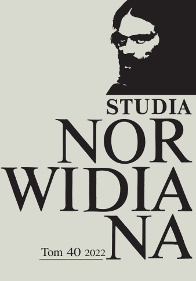“Sense and feeling in man”.Comments on Assunta Norwid in the light of Young Poland’s reception
Abstract
Assunta is a digressive poem showing Norwid’s views on art, philosophy and religion. According to the aesthetic assumptions of Romanticism, art has its source in internal experience, religious experience, and is of a metaphysical nature. Modernist interpretations of Norwid’s works, to which the article was devoted, reveal its metaphysical aspects. Determining the direction and significance of influences becomes an extremely important task. The author of Assunta was perceived at the end of the nineteenth century as a patron of modernism, his name was mentioned together with that of Baudelaire, comments about him appeared in the context of discussions on modern literature, theater and the art of acting. Norwid’s work was in line with the „paradigm of sight-centricism”, the poet did not avoid optical metaphors, he used the poetics of chiaroscuro and space framing, which in Assunt’s poem gained a vertical character. The motives of improvement and growth played an important role in the piece. Reflecting on their meaning allowed to establish the rank of the metapoetic remarks contained in Assunta. The works of Norwid, recalled in the era of modernism, have received many interpretations, including critical ones, based on „troublesome” concealments. Zenon Przesmycki believed that this work was not fully understood, although attempts were made to include it in the aesthetics of modernism. However, it was recognized that it was the missing link in the development of Polish symbolist poetry (it is also worth emphasizing its links with „colorists” – as the Impressionists were called). In Assunta, referring to the Divine Comedy by Dante and Shakespeare’s Hamlet, the contemplative path of knowledge is shown. „Looking to heaven” is therefore a cognitive act in which reason coexists with faith.
References
Arcimowicz W., Assunta C. Norwida. Poemat autobiograficzno-filozoficzny, Lublin 1933.
Buś M., Młodopolski Norwid – „legenda” czy „zagadnienie kultury”?, w: Stulecie Młodej Polski, red. M. Podraza-Kwiatkowska, Kraków 1995, s. 409-429.
Chlebowski P., „Przeciw tej nudzie przeklętej”: Norwid i melancholia, w: Światy melancholii. W 500-lecie Melancolii Albrechta Dürera (1514-2014), red. M. Dybizbański, A. Mazur, Opole 2015, s. 153-167.
Doktór R., Assunta jako poemat miłosny, „Studia Norwidiana” 11: 1993, s. 77-91.
Halkiewicz-Sojak G., Wobec tajemnicy i prawdy: o Norwidowskich obrazach „całości”, Toruń 1998.
Kuciak A., Norwid wobec Dantego: kilka przybliżeń, „Pamiętnik Literacki” 1996, nr 3, s. 33-59.
Leśmian B., Poezja, oprac. J. Trznadel, wyd. III, rozszerzone, Biblioteka Narodowa seria I nr 217, Wrocław–Warszawa–Kraków 1991.
Lijewska E., Norwid i Kierkegaard. Czy spotkanie było możliwe?, „Poznańskie Studia Polonistyczne. Seria Literacka” 2011, nr 18, s. 271-282.
Nieukerken A. von, „Witkacy-Norwid: projekt komparatystyki dekonstrukcjonistycznej, Wiesław Rzońca, Warszawa 1998 [recenzja], „Pamiętnik Literacki” 2001, z. 4, s. 205-218.
Przesmycki Z., Wybór pism krytycznych, oprac. E. Korzeniewska, Kraków 1967, t. 2.
Rzońca W., Premodernizm Norwida – na tle symbolizmu literackiego drugiej połowy XIX wieku, Warszawa 2013.
Sawicki S., Chrześcijańskie wartości poezji Norwida, Lublin 1986.
Siemieńska A., Motyw śmierci w poemacie Assunta i elegii Na zgon Poezji, w: Czytanie Norwida 2, Słupsk 2003, s. 81-88.
Skalińska E., Assunta jak świat, w: Norwid – interpretacje, red. T. Korpysz, Warszawa 2021, s. 207-223.
Śniedziewski P., Poeta skąpy w mowie. O milczeniu u Norwida, „Pamiętnik Literacki 2007, z. 4, s. 21-42.
Trybuś K., „Assunta” jako poemat metafizyczny, „Studia Norwidiana” 11: 1993, s. 93-101.
Woźniewska-Działak M., „Assunta (czyli Spojrzenie). Poema” – ku estetyce paraboliczności, w: tejże, Poematy narracyjne Cypriana Norwida. Konteksty literacko-kulturalne, Kraków 2014, s. 153-205.
Copyright (c) 2022 Studia Norwidiana

This work is licensed under a Creative Commons Attribution-NonCommercial-NoDerivatives 4.0 International License.





